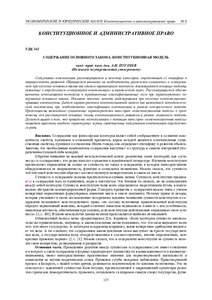Please use this identifier to cite or link to this item:
https://elib.psu.by/handle/123456789/1086Full metadata record
| DC Field | Value | Language |
|---|---|---|
| dc.contributor.author | Пугачев, А. Н. | - |
| dc.date.accessioned | 2014-01-27T13:20:17Z | - |
| dc.date.available | 2014-01-27T13:20:17Z | - |
| dc.date.issued | 2013 | - |
| dc.identifier.citation | Вестник Полоцкого государственного университета. Серия D, Экономические и юридические науки : научно-теоретический журнал.- Новополоцк : ПГУ, 2013. - № 6. - С. 137-145. | ru_RU |
| dc.identifier.uri | https://elib.psu.by/handle/123456789/1086 | - |
| dc.description | The Content of the Basic Law. Constitutional Model A. Pugachev the Content of the Constitution Is Regarded as a Category That Determines Its Specificity and Direction of Development. Attention Is Paid to the Necessity of Distinction Between the Essence and the Content of the Basic Law as a Single Regulatory Complex. the Main Approaches Related to the Definition of the Content of the Constitution in Jurisprudence are Analysed. the Validity of the Use of Typology and Traditional Classification Schemes in Describing of the Content of the Basic Law Is Considered. the Significance of the Modelling Method in the Study of Constitutional and Legal Institutions Is Indicated. the Characteristic of a Constitutional Model as the Most Important Methodological Components For the Classification of Constitutions in the Historical Approach Is Given. the Most Important Intrinsic Characteristics of the Category “Constitutional Model” and the Main Stages of Constitutional Development in the Framework of This Approach are Proposed. It Is Concluded That the Typology That Is Based on the Category of Constitutional Model Allows Us to Emphasize the Most Characteristic Features Peculiar to the Content of the Constitutions of Some Kind. | ru_RU |
| dc.description.abstract | Содержание конституции рассматривается в качестве категории, определяющей её специфику и направленность развития. Обращается внимание на необходимость различения «сущности» и «содержания» при изучении основного закона как единого нормативного комплекса. Анализируются основные подходы, связанные с определением «содержания конституции» в юридической науке. Рассматривается обоснованность использования типологии и традиционных классификационных схем при характеристике содержания основного закона. Показано значение метода моделирования при изучении конституционно-правовых институтов. Даётся характеристика конституционной модели как важнейшей методологической компоненты при необходимости классификации конституций в рамках исторического подхода. Представлены важнейшие сущностные характеристики категории «конституционная модель» и предложены для рассмотрения основные этапы конституционного развития в рамках указанного подхода. Делается вывод о том, что проведение типологизации с помощью категории «конституционная модель» позволяет выделить наиболее характерные черты, свойственные содержанию конституций определённого рода. | ru_RU |
| dc.language.iso | ru | ru_RU |
| dc.publisher | Полоцкий государственный университет | ru_RU |
| dc.relation.ispartof | Веснік Полацкага дзяржаўнага ўніверсітэта. Серыя D, Эканамічныя і юрыдычныя навукі | be_BE |
| dc.relation.ispartof | Herald of Polotsk State University. Series D, Economics and law sciences | en_EN |
| dc.relation.ispartof | Вестник Полоцкого государственного университета. Серия D, Экономические и юридические науки | ru_RU |
| dc.relation.ispartofseries | Серия D, Экономические и юридические науки;2013. - № 6 | - |
| dc.rights | open access | ru_RU |
| dc.subject | Конституционное право | ru_RU |
| dc.subject | конституционные модели | ru_RU |
| dc.subject | типологии | ru_RU |
| dc.subject | правовые термины | ru_RU |
| dc.subject | классификации | ru_RU |
| dc.subject | классификационные схемы | ru_RU |
| dc.subject | конституции | ru_RU |
| dc.subject | моделирование | ru_RU |
| dc.title | Содержание основного закона. Конституционная модель | ru_RU |
| dc.type | Article | ru_RU |
| Appears in Collections: | 2013, № 6 | |
Files in This Item:
| File | Description | Size | Format | |
|---|---|---|---|---|
| 137-145.pdf | 314 kB | Adobe PDF |  View/Open |
Items in DSpace are protected by copyright, with all rights reserved, unless otherwise indicated.